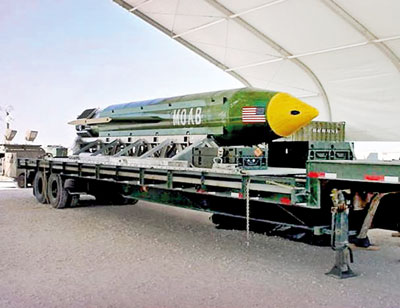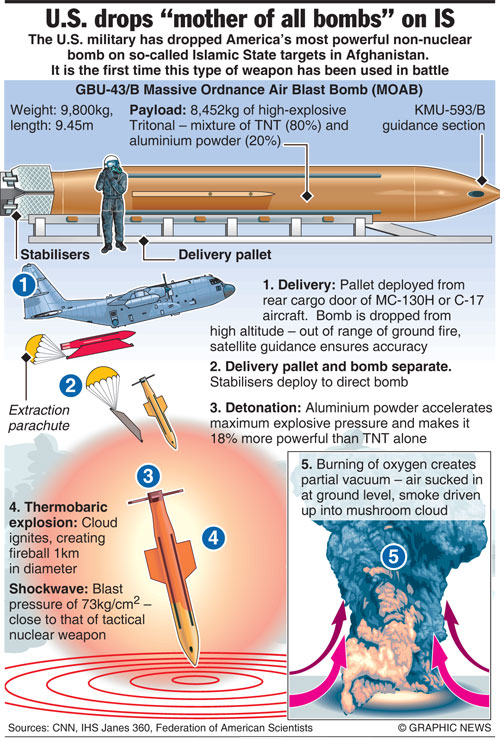Sunday Times 2
‘Right time’ to use huge bomb in Afghanistan: US General

The GBU-43/B Massive Ordinance Air Blast (MOAB) bomb is pictured in this undated handout photo. Elgin Air Force Base/Handout via REUTERS
The top US military commander in Afghanistan said on Friday that the decision to deploy one of the largest conventional bombs ever used in combat was purely tactical, and made as part of the campaign against Islamic State-linked fighters. As many as 36 suspected Islamic State militants were killed in the strike on Thursday evening in the eastern province of Nangarhar, Afghan defense officials said, adding there were no civilian casualties.
Amaq, the news agency affiliated with Islamic State, carried a statement denying that the group had suffered casualties in the attack.
The statements could not be independently verified, and on Friday Afghan and foreign troops in the vicinity were not allowing reporters or locals to approach the scene of the blast.
The strike came as US President Donald Trump prepares to dispatch his first high-level delegation to Kabul, amid uncertainty about his plans for the American troops stationed in Afghanistan.
Nicknamed “the mother of all bombs,” the weapon was dropped from an MC-130 aircraft in the Achin district of Nangarhar, bordering Pakistan.
Nicholson said the decision to use the 9,797kg GBU-43 bomb was based on his assessment of military needs and not broader political considerations. “This was the first time that we encountered an extensive obstacle to our progress,” he said of a joint Afghan-US operation that has been targeting Islamic State since March. “It was the right time to use it tactically against the right target on the battlefield.”
Afghan Defence Ministry spokesman Dawlat Waziri said no civilians were harmed in the massive blast that targeted a network of caves and tunnels that had been heavily mined.
The GBU-43 is a GPS-guided munition that had never before been used in combat since its first test in 2003, when it produced a mushroom cloud visible from 32 km away. The bomb’s destructive power, equivalent to 11 tonnes of TNT, pales in comparison with the relatively small atomic bombs dropped on Japan at the end of World War Two, which had blasts equivalent to between 15,000 and 20,000 tonnes of TNT.
In Achin village, about 5 km from the remote, mountainous area where the bomb was dropped, witnesses said the ground shook, but homes and shops appeared unaffected. Qari Mehrajuddin first saw “lightning like a thunder storm” followed by the roar of an explosion, an all-too-familiar sound for residents of the war-torn area.
Some locals welcomed the strike. “If you want to destroy and eliminate Daesh, then even if you destroy my home we won’t complain, because they are not human beings, they are savages,” said Mir Alam Shinwari, using an Arabic term for Islamic State.
Away from Achin, reactions were mixed. “The fact is that America used their big bomb here to test its effectiveness,” said Kabul resident Asadullah Khaksar. “If America wants to eliminate Daesh, it is very easy because they created this group.”
The United Nations has raised concerns that the American air campaign is swelling civilian casualties in Afghanistan. Last year, air strikes by international forces caused at least 127 civilian deaths and 108 injuries, up from 103 deaths and 67 injuries in 2015, the United Nations said.

ACHIN, April 15 (Reuters)Â

